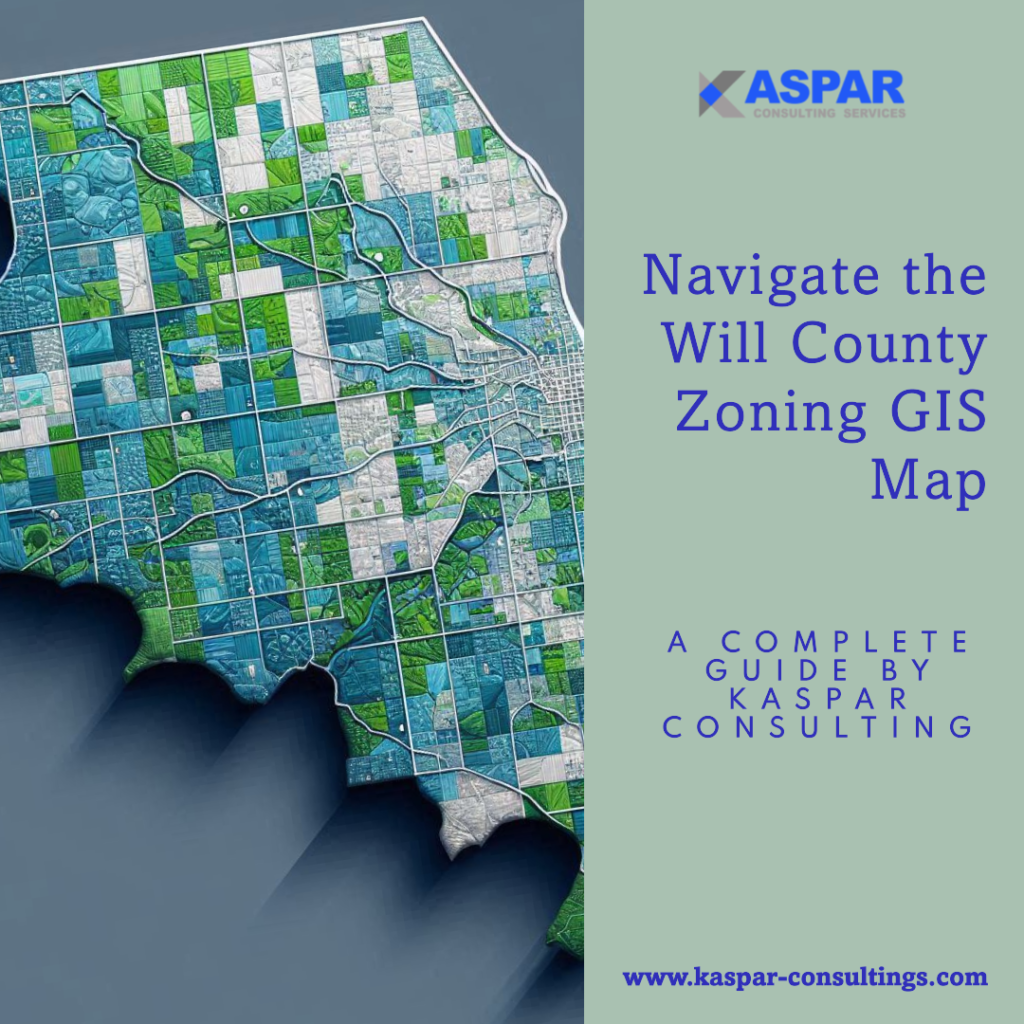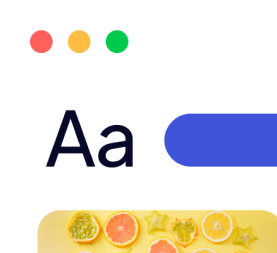
Unlock Zoning Information Like Never Before with Kaspar Consultings’ GIS Solutions!
In today’s fast-paced world of development and urban planning, access to accurate zoning information is vital for businesses, real estate developers, and local government officials. The Will County Zoning GIS Map provides a comprehensive solution to accessing this data, enabling users to explore zoning regulations, parcel boundaries, and land-use details with ease. The ability to visualize and interact with geographic and zoning data through this GIS (Geographic Information System) platform not only helps in decision-making but also ensures that developers comply with local zoning ordinances.
At Kaspar Consultings, we specialize in taking this technology a step further by offering custom GIS development services to enhance navigation, functionality, and user experience. Whether you need to optimize zoning workflows, plan new developments, or simply stay informed on land-use restrictions, Kaspar Consultings is your partner in leveraging GIS technology for better decision-making.
Section 1: What is the Will County Zoning GIS Map?
Navigate Zoning with Precision: Kaspar Consultings Brings GIS Innovation to Will County!
The Will County Zoning GIS Map is an advanced digital tool that provides essential zoning information for Will County, Illinois. Powered by Geographic Information Systems (GIS), the map offers a user-friendly interface where land-use planners, developers, and even residents can access crucial data about zoning classifications, land boundaries, parcel ownership, and more.
What Does GIS Offer?
GIS is a powerful technology used to capture, store, analyze, and present spatial or geographic data. In the case of the Will County Zoning GIS Map, GIS enables users to visualize how land is zoned across the county, understand what activities are allowed in different areas, and make informed decisions regarding land use. GIS maps like this one are essential for:
- Real estate development
- Urban and regional planning
- Public safety management
- Environmental impact assessments
- Infrastructure planning
Kaspar Consultings enhances existing GIS platforms by customizing them to meet the specific needs of businesses, real estate professionals, and local authorities. With our expertise, the Will County Zoning GIS Map can become more than just a resource—it becomes a dynamic tool for making better decisions.
Section 2: How to Access the Will County Zoning GIS Map
Easy Access, Enhanced by Kaspar Consultings’ GIS Expertise!
The Will County Zoning GIS Map is a publicly accessible tool that provides essential zoning and parcel information. Here’s a step-by-step guide to help you navigate and extract the most valuable insights from it.
Step-by-Step Access to the Will County Zoning GIS Map:
- Visit the Official Will County GIS Website: The map can be accessed directly through Will County’s official website. Kaspar Consultings offers custom integrations that simplify this process, embedding the GIS map into your company’s intranet or business platform for seamless access.
- Search for Specific Parcels: Once on the map interface, use the search function to locate specific parcels by entering the parcel number, address, or intersection. The search tool is intuitive, allowing users to locate the exact parcel or area of interest with ease.
- Layer Controls: The Will County GIS map provides several layers to explore, including zoning districts, flood zones, and environmental areas. Use the layer control options to toggle between different overlays that best suit your needs.
- Measure Distances and Area: The GIS platform includes measurement tools that allow you to calculate the distance between two points or measure the area of a specific parcel.
- Download Zoning Data: Data can be exported and saved for later reference. Whether you’re presenting to a client or preparing a zoning analysis, the download feature ensures you have all the data at your fingertips.
Enhancing the GIS Experience with Kaspar Consultings:
While the Will County Zoning GIS Map offers a robust set of tools, Kaspar Consultings can significantly improve the platform by customizing it to fit your needs. Whether it’s building a user-specific interface, integrating advanced analytical tools, or optimizing the system for mobile devices, our GIS solutions are designed to make zoning management more efficient and effective.
Section 3: Key Features of the Will County Zoning GIS Map
Explore with Power: Unlock the Full Potential of the Will County GIS Map with Kaspar Consultings!
The Will County Zoning GIS Map includes several powerful features that allow users to interact with the data in meaningful ways. These features offer the flexibility needed for a wide range of applications, from real estate development to government land management.
Core Features of the Will County Zoning GIS Map:
- Parcel Search Functionality: Quickly locate parcels by address or parcel number, and access the zoning regulations for each plot of land. This feature allows real estate developers and planners to confirm that their proposed projects align with local zoning regulations.
- Zoning District Overlays: The map allows users to visualize the boundaries of zoning districts across the county, including residential, commercial, industrial, and mixed-use zones. With these overlays, developers can assess how their projects will fit into the overall zoning plan for a given area.
- Layering Capabilities: Users can overlay additional data points, such as environmental protections, flood plains, and infrastructure details. These layers provide critical insights that may impact project feasibility.
- Measurement Tools: Users can measure distances, areas, and perimeters, making it easier to plan the layout of new developments. Kaspar Consultings can add advanced measurement tools, allowing users to calculate building coverage ratios and potential impact zones for new constructions.
- Property Ownership Information: In addition to zoning classifications, users can also view property ownership details. This can be particularly helpful for real estate developers or government officials looking to assess land for future projects.
Customization Options with Kaspar Consultings:
While these features are powerful, Kaspar Consultings can enhance them even further by developing advanced GIS functionalities tailored to specific needs. This might include adding predictive modeling capabilities, integrating real-time data feeds, or enabling multi-platform accessibility. By customizing these tools, Kaspar Consultings ensures that zoning data becomes a dynamic resource for effective decision-making.
Section 4: Benefits of Using the Will County Zoning GIS Map
Make Data-Driven Decisions with Kaspar Consultings’ Custom GIS Solutions!
The benefits of using the Will County Zoning GIS Map extend far beyond simply understanding zoning laws. For businesses, developers, and local governments, the map offers a wide range of advantages that can streamline operations and improve decision-making.
Key Benefits:
- Improved Planning and Development: The map provides essential information that helps planners and developers ensure compliance with zoning regulations. By using the zoning overlays and parcel data, users can align their projects with local ordinances, avoiding costly delays or compliance issues.
- Cost and Time Efficiency: Having immediate access to zoning and parcel information reduces the need for physical site visits or paper records. This convenience translates into both time and cost savings, particularly for businesses that need to process large volumes of zoning data.
- Risk Mitigation: The ability to quickly access data on flood zones, environmental protections, and other potential hazards allows developers to avoid risky investments. Kaspar Consultings can integrate additional risk assessment tools into the GIS system, further enhancing this capability.
- Transparency in Land Use: The public nature of the GIS map promotes transparency in zoning and land-use decisions. Developers can easily demonstrate that their projects are compliant with local zoning ordinances, reducing potential conflicts with residents or local authorities.
- Data Integration: The GIS map integrates a wide range of data points, making it a one-stop-shop for zoning and land-use information. Kaspar Consultings can build on this by integrating custom data layers, such as economic development zones, transportation networks, or business districts, giving users even deeper insights into land-use possibilities.
How Kaspar Consultings Enhances These Benefits:
At Kaspar Consultings, we recognize that every business or project has unique needs. That’s why we offer tailored GIS solutions designed to help you extract maximum value from the Will County Zoning GIS Map. Our enhancements improve the user interface, expand the data available for analysis, and ensure that all tools are mobile and desktop-compatible.
Section 5: Zoning Classifications and Their Importance
Master Zoning Rules with Custom GIS Maps by Kaspar Consultings!
Understanding zoning classifications is crucial for developers, planners, and local government officials. Zoning laws dictate how land can be used, from residential to commercial to industrial purposes, and failure to comply can result in significant penalties.
Primary Zoning Classifications on the Will County Zoning GIS Map:
- Residential Zoning: This classification governs areas intended for housing, such as single-family homes or multi-family residences. It’s critical for developers to ensure their projects meet local residential zoning regulations to avoid legal complications.
- Commercial Zoning: Areas designated for businesses, including retail, office spaces, and entertainment venues. Commercial zoning often includes restrictions on the size and scope of developments, which can impact the planning process for large-scale projects.
- Industrial Zoning: Designed for manufacturing, production, and large-scale operations, industrial zones require specific considerations, such as proximity to infrastructure and environmental compliance.
- Mixed-Use Zoning: In these zones, a combination of residential, commercial, and sometimes industrial uses is allowed. These areas are popular for urban development projects and require careful planning to ensure compatibility between different land uses.
- Special Purpose Zoning: This classification covers areas designated for public use, parks, schools, or other special purposes. Developers looking to build near these designated areas must pay close attention to local zoning regulations to ensure compliance and community alignment.
The Importance of Understanding Zoning Classifications
Navigating zoning classifications is essential for several reasons:
- Regulatory Compliance: Each zoning classification comes with its own set of regulations. Understanding these rules helps developers ensure their projects comply with local laws, reducing the risk of legal challenges or penalties.
- Development Potential: Different zoning classifications dictate what types of buildings and activities are permissible. Understanding these classifications enables developers to identify suitable locations for their projects, maximizing potential success.
- Community Impact: Zoning classifications can significantly affect local communities. For instance, a new commercial development in a residential area may lead to increased traffic and noise, which can impact residents’ quality of life. By understanding zoning classifications, developers can engage with the community effectively and design projects that align with local needs.
- Long-Term Planning: Zoning regulations can change over time based on community needs, political landscapes, and urban development trends. Being aware of these changes allows developers and planners to anticipate future zoning shifts and adjust their projects accordingly.
- Investment Security: Projects that align with zoning regulations are less likely to face legal challenges or delays, providing a greater degree of security for investors. Developers can present a solid case to potential investors when they demonstrate a thorough understanding of zoning classifications.
Enhancing Understanding through Kaspar Consultings
Kaspar Consultings can provide custom training sessions and resources to help businesses and individuals better understand zoning classifications and their implications. Our GIS solutions are designed to empower users with the knowledge and tools they need to navigate complex zoning laws effectively.
Section 6: Case Study: Utilizing the Will County Zoning GIS Map for Successful Development
Transform Your Project’s Success with Kaspar Consultings’ GIS Expertise!
Let’s explore a case study that illustrates the practical applications of the Will County Zoning GIS Map and the value of Kaspar Consultings’ GIS solutions.
Case Study: A Mixed-Use Development in Will County
A local developer aimed to create a mixed-use development in a growing area of Will County. The project sought to combine residential apartments with commercial spaces to foster a community-oriented environment. However, before commencing, the developer faced several challenges:
- Zoning Compliance: The developer needed to confirm that the proposed site was in a mixed-use zoning district and met all local zoning requirements.
- Community Engagement: Engaging the local community was crucial for project buy-in, but the developer needed accurate data to address community concerns effectively.
- Site Analysis: An in-depth site analysis was required to assess environmental factors, access to transportation, and proximity to utilities.
Using the Will County Zoning GIS Map
By leveraging the Will County Zoning GIS Map, the developer was able to access essential information quickly and efficiently:
- Zoning Confirmation: Using the parcel search functionality, the developer confirmed that the chosen site was indeed zoned for mixed-use development. This initial step eliminated potential compliance issues down the line.
- Layered Data Analysis: The developer used various map layers to assess flood zones and environmental restrictions, ensuring that the site would support the proposed construction without violating any regulations.
- Community Insights: By analyzing demographic data available through the GIS platform, the developer could tailor the project to meet the needs of the community. This included designing retail spaces that catered to local preferences and ensuring sufficient green spaces for residents.
- Risk Mitigation: With access to critical data on nearby utilities and infrastructure, the developer identified potential challenges early in the process. Kaspar Consultings provided custom tools to simulate the impact of the project on local traffic patterns and environmental conditions.
Project Outcome
Thanks to the insights provided by the Will County Zoning GIS Map and the tailored GIS solutions from Kaspar Consultings, the developer successfully completed the project on schedule. The development not only met local zoning regulations but also garnered positive community feedback, leading to a thriving mixed-use space that aligned with the residents’ needs.
This case study highlights the transformative potential of using GIS tools for informed decision-making and successful project outcomes in zoning and land-use planning.
Section 7: Future Trends in Zoning and GIS Technology
Stay Ahead of the Curve with Kaspar Consultings’ Innovative Solutions!
As technology evolves, so too does the field of zoning and land-use planning. The future of GIS and zoning maps promises to be exciting, with advancements that can significantly enhance the functionality and usability of tools like the Will County Zoning GIS Map.
Emerging Trends in GIS Technology for Zoning:
- Real-Time Data Integration: Future GIS maps are likely to incorporate real-time data, such as traffic patterns, environmental conditions, and public utilities. This integration will allow users to make more informed decisions based on current conditions rather than static historical data.
- Mobile Optimization: As more professionals work remotely or on-site, mobile optimization for GIS tools will become increasingly important. Future iterations of the Will County Zoning GIS Map will likely offer enhanced mobile features, making it easier for users to access zoning information on the go.
- Predictive Analytics: Advanced analytics tools will help users forecast potential zoning changes, community needs, and development trends. By using machine learning algorithms to analyze existing data, GIS platforms can provide insights that guide future zoning regulations and development opportunities.
- Public Engagement Tools: Enhanced public engagement features will enable local governments and developers to communicate more effectively with residents. Interactive maps that allow residents to provide feedback on proposed zoning changes or developments will foster community involvement.
- 3D Visualization: Future GIS tools may incorporate 3D visualization capabilities, allowing users to view zoning data in three dimensions. This technology could provide deeper insights into how new developments will impact the surrounding environment and community.
Kaspar Consultings at the Forefront of GIS Innovation
At Kaspar Consultings, we are committed to staying ahead of technological advancements in GIS. Our team is continually exploring ways to integrate new tools and features into existing platforms, ensuring that our clients have access to the most effective zoning solutions. Whether through enhanced mobile interfaces or advanced predictive analytics, we aim to empower our clients with the tools they need for successful land-use planning and development.
Conclusion
Take Control of Your Zoning Projects with Kaspar Consultings’ Expertise!
The Will County Zoning GIS Map is a powerful resource for anyone involved in land-use planning, development, or local government. With its user-friendly interface and robust features, it simplifies the complex world of zoning regulations, making it easier to access crucial information that drives informed decision-making.
As you navigate the intricacies of zoning regulations, remember that you don’t have to do it alone. With the support of Kaspar Consultings, you can optimize your use of the Will County Zoning GIS Map and develop tailored GIS solutions that meet your specific needs. Our expertise in GIS development will help you harness the full potential of zoning data, ensuring compliance, improving community engagement, and maximizing project success.
If you’re ready to take your zoning and land-use planning to the next level, contact Kaspar Consultings today! Let us help you unlock the potential of the Will County Zoning GIS Map and make informed decisions that benefit your projects and the community.




